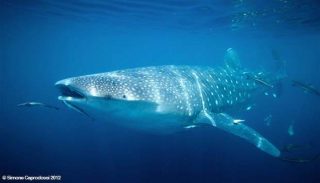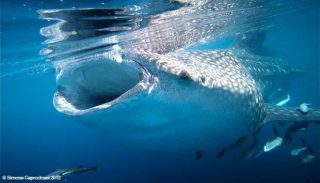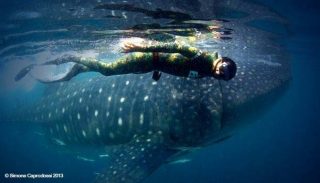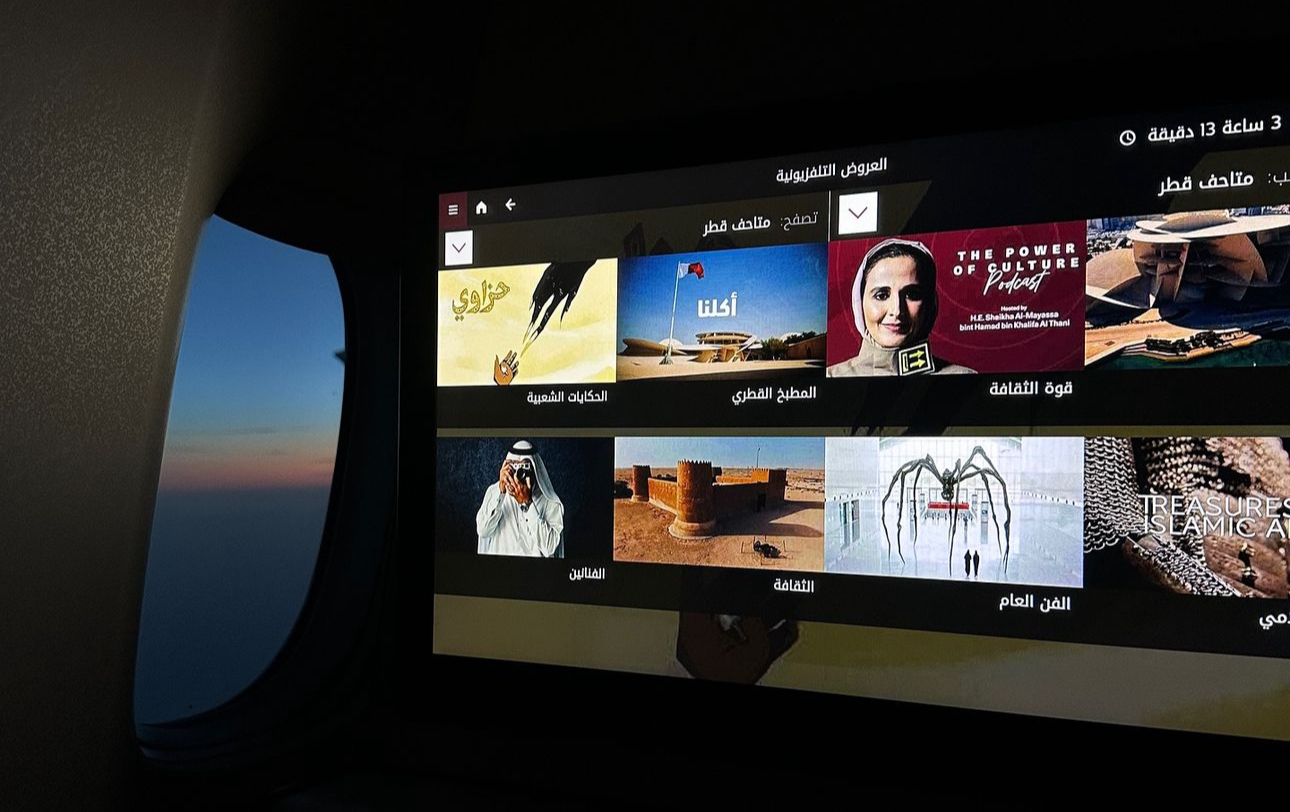All photos courtesy of Simone Caprodossi/Qatar Whale Shark Research Project
To the surprise of researchers, hundreds of the world’s largest sharks are choosing the waters off of Qatar’s coast as their primary summertime habitat.
The Gulf was historically thought to be too hot for the whale shark, a creature that’s been dubbed a “gentle giant” and known to grow up to 18m long – larger than a typical bus.
Historically, this type of shark was more commonly found off Mexico’s Yucatan Peninsula, around the Galápagos Islands, in the Red Sea near Djibouti and off the coast of Taiwan, among other places.
But in recent years, congregations of more than 100 whale sharks have been observed around several of Qatar’s offshore oil platforms, which provide a “sanctuary” for the creatures and the mackerel tuna upon whose eggs they feed.

The Al Shaheen oil field – which is located 90km off Qatar’s coast near the country’s maritime border with Iran – is a high-security zone that’s mostly closed to the public.
With minimal boat traffic, researchers say some of the oil platforms appear to have flourished as artificial reefs.
“They are attracting a lot of reef species that you don’t see in the sandy Gulf,” said Steffen Bach, a senior environmental advisor with the Maersk Oil Research and Technology Center in Qatar.
Thousands of colorful fish now swim among the sponges and soft corals growing on the oil platforms, researchers say, “creating a marine oasis is a desert sea.”
Local researchers are currently working to estimate the size of Qatar’s whale shark population, as well as gain a better understanding of what exactly is attracting the creatures to the area.
Next year, they will also host some of the world’s leading experts in the field when the International Whale Shark Conference comes to Qatar in May 2016. This will be the first time the event will be held in the Middle East.
“It will put Qatar on the map for whale sharks,” Bach told Doha News, adding that the event will show that the country’s waters are “a biodiversity hotspot.”
Unanswered questions
Research into whale sharks in the Gulf started in 2007 when Soren Stig, a Maersk Oil offshore worker, snapped photos of more than 100 whale sharks surrounding a platform and posted them online.
However, it wasn’t until 2010 that intense study began after David Robinson, who was conducting research for his doctoral thesis at Heriot-Watt University on whale sharks in the Gulf, found the images.
Robinson contacted Qatar’s Ministry of the Environment, where Mohammed Al Jaidah – together with Maersk Oil and Heriot-Watt University – formed the Qatar Whale Shark Research Project.
Surveys to the Al Shaheen field began in April 2011.
Since then, nearly 400 different whale sharks have been identified in Al Shaheen using photographs that capture each animal’s unique spotted skin markings. Researchers have also used acoustic, satellite and light level tags to learn more about the creature’s movements.
But they still have many unanswered questions. For example, whale sharks are spotted in Al Shaheen almost exclusively between the months of April and October, and it’s still not clear where they go during the winter.
One theory, according to a 2013 academic paper, is that many leave the Gulf and travel more broadly within the Arabian Sea, an idea supported by the fact that whale shark sightings in the Strait of Hormuz and Gulf of Oman peak in April and November – just before and after they gather in Qatar’s waters.
Bach said he’s also been trying to verify the importance of the offshore platforms in attracting whale sharks and mackerel tuna.
He said the fact that whale sharks are spotted around some platforms and not others suggests “something else is going on.”
One of this theories involves water currents.
In the summer, several cyclone-shaped “transition zones” appear around Al Shaheen as water coming in from the Arabian Sea mixes with river water discharged from Iraq. This affects the water’s temperature, nutrient content, the amount of food for mackerel tuna and where their eggs end up.
“(Al Shaheen) is not necessarily the choice of whale sharks. It’s where they are going to eat,” Bach said.
Protection
One of the reasons that it’s important to understand the role of the platforms themselves is that offshore equipment is typically decommissioned and removed once oil fields are depleted.
While Al Shaheen is expected to continue producing oil for many years to come, Bach said he wants to learn more about the relationship between whale sharks and the artificial reefs in the Gulf.

But there are other more pressing threats to the species, which is considered “vulnerable” by international conservation authorities. This designation means it faces a high risk of extinction in the wild.
The International Union for Conservation of Nature said the global population is in decline and is threatened by legal and illegal fishing, including accidental catches.
Locally, researchers have documented significant scars on several whale sharks left by boat propellers. While it’s not known where the incidents occurred, the Strait of Hormuz – a narrow and heavily trafficked shipping channel – is one possibility.
Bach said he hopes next year’s conference in Qatar attracts regulators from across the GCC, who could develop conservation guidelines aimed at protecting whale sharks in the region.
Before then, however, researchers have another busy summer of offshore monitoring ahead of them. Bach said he and his colleagues typically make about 20-odd trips annually to Al Shaheen.
He described getting into the water and swimming among the massive creatures as “one of the most amazing experiences I’ve ever had.”
“When you recognize a whale shark by its spots and scars, you think, ‘Hey, you’re back.’ It almost like you’re part of the family.”
Thoughts?










